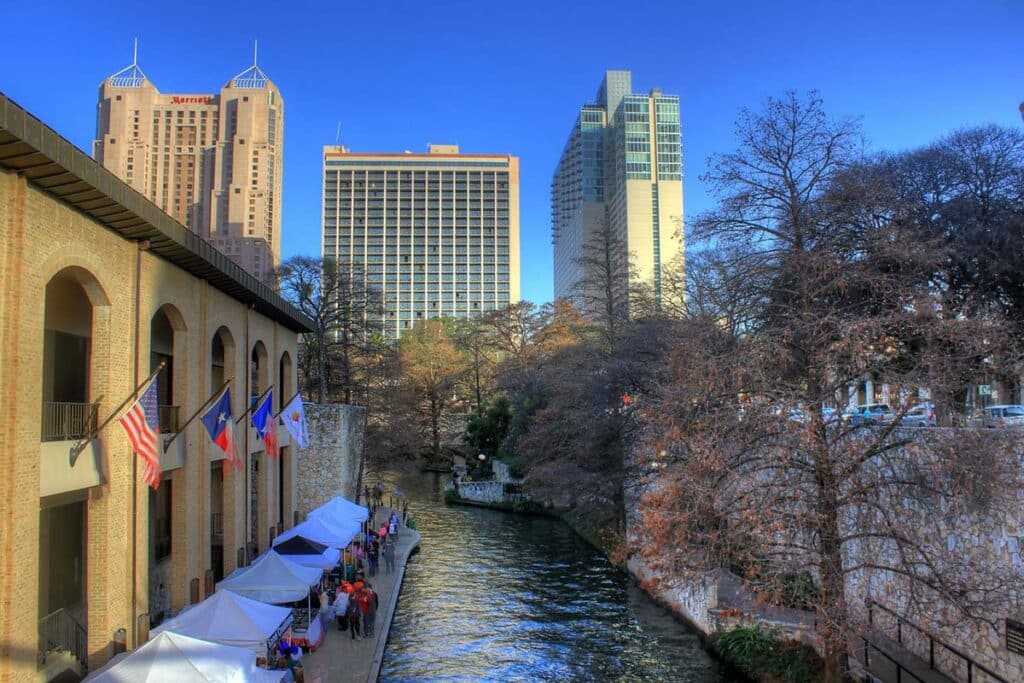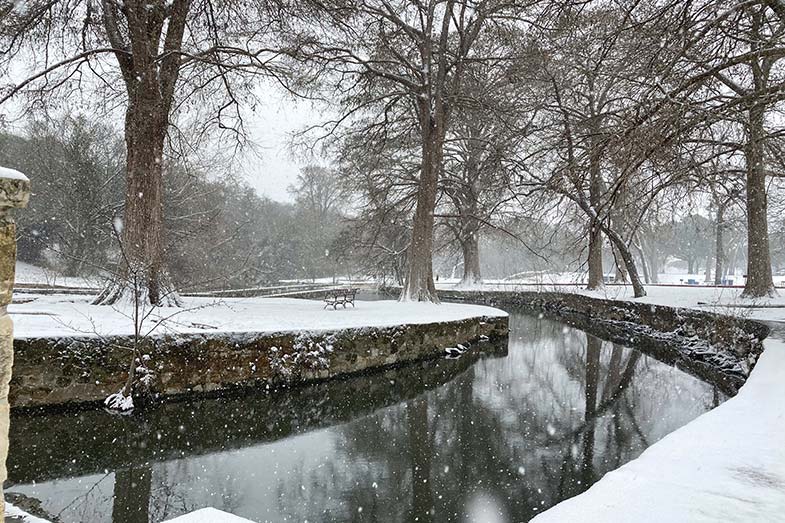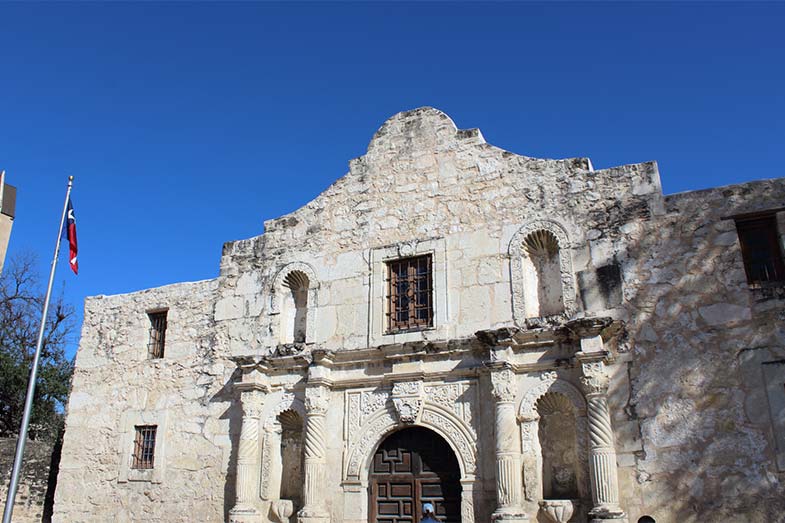San Antonio is a subtropical region known for its long, muggy summers and cloudy skies. Despite having anecdotal instances of snowfall, it usually only gets minor traces of snow during winter. With the city sometimes getting its unusual share of snowstorms, you may be wondering, ‘Does it snow in San Antonio?’ And if so, how often?
Yes, it does snow in San Antonio, although snowfall is unpredictable and occurs every ten years or so. Since the 1900s, the city has only received an average snowfall of less than 5 inches per decade. However, with the growing effects of climate change, this weather pattern will soon change.
For the city’s tourists and permanent residents, a colder, snow-dusted winter season would be very much appreciated – but hopefully, without any incidents of forced blackouts and an increase in vehicle accidents. That said, read on and know what to expect of San Antonio’s weather.

When Does It Snow in San Antonio, Texas?
San Antonio’s winter season runs from December to February and is mild with temperature variations. Hot days occur even during this period, with ambient temperature as high as 77 °F. Conversely, it can get chilly at night, with temperatures dropping below freezing and reaching up to 14 °F or below when cold waves hit the region.
| Month | Average Snowfall / Day(s) | Temperature Range |
|---|---|---|
| December | 0.04 inches / 0.1 days | 46.9 °F to 62.4 °F |
| January | 0.08 inches / not indicated | 44.2 °F to 61.7 °F |
| February | 0.08 inches / not indicated | 48.2 °F to 65.8 °F |
How Often Does San Antonio, Texas Get Snow?
In San Antonio, snowfall is rare, but freezing rain can occur. Barring unprecedented precipitation and blizzards, temperature ranges during winter can fall between 44.2 °F and 65.8 °F across all three months, with January being the coldest and the cloudiest. By February, the weather already begins to become warm and pleasant – although historically, the highest daily snowfall for the city seems to always occur during this month.
| Month | Precipitation | Day(s) |
|---|---|---|
| December | 1.1 inches (28 millimeters) | 9.9 |
| January | 1.14 inches (29 millimeters) | 9.1 |
| February | 0.98 inches (25 millimeters) | not indicated |
Higher-elevation areas like Black Hill have a higher propensity for precipitation (even rare snowfall) versus inland Texas. In South-Central Texas, Midland sees the biggest amounts of snow, with yearly accumulated snowfall ranging from 0.2 – 5.1 inches. Everywhere else in the state has comparable figures, except for West Texas, which gets up to 17.8 inches of snow.
Snowball’s Chance: Worst San Antonio Winters

While San Antonio, Texas, has a generally subtropical climate, the city did have its share of rather uncharacteristic snowstorms in the past few decades. Many speculate that these incidents were from climate change or the recent La Niña wave that hit North America. Either way, the phenomenon seems to be happening once again, as a slew of severe winter storms hit the Bexar County and surrounding areas of Texas in February 2021.
San Antonio Snowstorm of 1985
An Arctic front that began just before midnight was responsible for dumping this record amount of San Antonio snow back on January 12-13, 1985. The city got 13.5 inches of snow in a matter of hours – the exact opposite of initial NWS (National Weather Service) predictions and the most San Antonio has seen in over a century!
It was an unforgettable experience for kids of that generation who had never seen snow in Southern Texas. Still, the mayor had to order citizens to stay indoors and businesses to remain closed until the 33.5 inches of accumulated snow had dissipated and roads were cleared of icy obstacles.
Panhandle Blizzard of 1957
Between March 22 and 25, 1957, the Texas and Oklahoma Panhandle experienced a rare phenomenon that ranked 3rd among the top ten weather events of the 20th century. The entire area, including San Antonio, was hauled over by a calamitous winter storm that dropped almost 20 inches of snow. It also brought snowdrifts of up to 30 feet (brought about by wind gusts nearing 60 mph).
The blizzard caused main roads to be impassable and even snowplows to get stranded. This snowstorm not only resulted in travel difficulties and power loss but also claimed 11 lives and about 20% of Texas’ livestock – ultimately amounting to $56M in damages.
North American Winter Storm of 2021
Winter Storm Uri occurred on February 13-17, 2021 – during which time San Antonio experienced an average of 3.7 inches of snow (7 inches in isolated pockets) and rolling power outages. Furthermore, an official count of 263 people perished due to vehicle crashes, hypothermia, carbon monoxide poisoning, and other chronic medical conditions aggravated by the snowstorm.
This incident cemented the standing of the Alamo State as the 8th deadliest U.S. state for wintertime vehicle accidents. It also resulted in $196.5B in damages, making Winter Storm Uri the costliest recorded winter storm and most expensive insurance event in Texas history. Up until several days after the actual snowstorm, power was still being restored for nearly half of the state, and the total number of fatalities was still being finalized.
Winter Storm Goliath of 2015
This calamitous blizzard hit the Southern Plains on December 26-28, 2015, impacted New Mexico and Texas (especially Lubbock), and dumped 9-10 inches of rain in a belt across the central U.S. It also brought snowdrifts of more than eight feet and heavy snowfall accompanied by strong wind gusts of up to 50 mph, making post-holiday travel conditions extremely difficult. Wind chills made record-breaking temperatures feel as if they were -5 °C. This snowstorm goes down in history as one of the worst Texas has ever seen.
North American Ice Storm of 2017
Considered the worst ice storm of the decade, the North American Ice Storm of 2017, between January 10 and 17, 2017, impacted the Great Plains (from north of Dallas to the south of San Antonio), Pacific Northwest, and American Midwest. This icy phenomenon spanned approximately 1,000 miles and brought about fallen trees and back-to-back power outages.
Hazardous driving conditions and other similar circumstances led to traffic incidents and untoward fatalities, causing multiple states alongside Texas to declare a state of emergency. Most precipitation took the form of accumulated ice and snowfall on the roads and fell as freezing rain on high elevations.
Other notable winter storms were the January 1886 Blizzard and the Houston Snowstorm of 1960 – although these blizzards were not necessarily concentrated in San Antonio. There were also specific dates in the past century when the city recorded its highest daily snowfall, as follows:
| Date | Snowfall Amount |
|---|---|
| January 30, 1949 | 4.7 inches (11.9 inches total accumulation) |
| February 22, 1966 | 3.1 inches (7.9 inches total accumulation) |
| February 8, 1973 | 2 inches (5.1 inches total accumulation) |
| February 21, 1964 | 2 inches (5.1 inches total accumulation) |
Nonetheless, the above winter storms and dates did not record the state’s coldest temperatures. Interestingly, Texas’ chilliest temperatures happened in 1899 and 1933, when both Tulia, Texas (1899) and Seminole, Texas (1933) recorded -23 °C (-9.4 °F) in February. In San Antonio, the lowest value recorded was -20 °C (-4 °F) on January 31, 1949.
Top Attractions in San Antonio

San Antonio, Texas, may not be the ideal getaway for the winter enthusiast, but the city still has scenic views and historical sites to offer. After all, the city is more than just a vast desert. With its majestic mountains, huge lakes, and dense forest areas, adventurers have tons to explore and enjoy.
1. The Alamo
Otherwise known as the Mision San Antonio de Valero, The Alamo is a Spanish-mission-turned-museum in downtown San Antonio. The historic site highlights the events of the Battle of the Alamo, which was a key event in the Texas Revolution that aimed at independence from Mexico. It also preserves the missions of colonial masters who used to make inroads across Spanish-occupied Southwest America in the 17th through 19th centuries. No matter the season, knowing more about your state is always a worthy substitute for winter activities.
2. San Antonio River Walk
The San Antonio River Walk is another exciting destination where you can while away your time while getting to know more about the city and its culture. This urban waterway starts four miles north of the city center, stretches fifteen miles long, flows through five miles of downtown San Antonio, and ends just south of the city, near Mission Espada. Many tourists enjoy the section that skirts the King William District, followed by the shop-restaurant-bar stretch.
3. Tower of the Americas
Designed by Architect O’Neil Ford, the Tower of the Americas is a 750-foot soaring landmark built for the 1968 HemisFair. It is in the south-eastern portion of the city. The Tower provides guests a stunning panoramic view of the Alamo City from its revolving Chart House Restaurant and Observation Deck. Admission costs just $14 for adults and less for senior citizens and military personnel.
4. Natural Bridge Caverns
The name of Texas’ premier natural attraction and largest known commercial caverns comes from the 60-foot bridge spanning the amphitheater setting of its entrance. The place is famous due to the original explorers’ painstaking efforts to cautiously climb and crawl through two miles of cavern passage, resulting in this must-visit attraction. It is next to the Natural Bridge Wildlife Ranch, with tours scheduled every 40 minutes. Admission fees range from $24.99 to $28.50 (sans tax).
5. San Fernando Cathedral
This church was built by Architect Francois P. Giraud and founded on March 9, 1731. The Cathedral of Our Lady of Candelaria and Guadalupe is Texas’s oldest functioning religious community and the first church built in San Antonio. For tourists, making a stop at this beautiful church is a must.
6. El Mercado (Historic Market Square)
This part of San Antonio is where the city’s culture comes alive. El Mercado has bustling shops, live entertainment, and the flavors of Old Mexico. Vendors sell fresh produce, honey, souvenirs, and Texas pecans. This three-block outdoor plaza is a crowd favorite, where both vacationers and locals gather every weekend and during festivities to eat, drink, shop, and have fun.
7. La Villita Historic Arts Village
A site that translates to ‘little village,’ La Villita Historic Arts Village is a local attraction that offers nearly three centuries of history and unique tales from people who’ve taken refuge within its walls. Established in 1939, this neighborhood became a cultural center for teaching arts and crafts. It is now under San Antonio’s Department for Culture and Creative Development.
8. Enchanted Rock State Natural Area
This 4.25-mile-long trail is a must-visit for nature lovers and adventurers who want to substitute snowboarding with hiking and incredible views. You can reach the peak of the iconic Summit Trail in 2-3 hours, but it may take longer with more stops. At the top, you will see the dome of the 425-foot pink granite batholith, the 2nd largest in America.
9. San Antonio Missions National Historical Park
Established on November 10, 1978, through the joint efforts of the Catholic Archdiocese of San Antonio and the U.S. Congress, this historical park is the only UNESCO World Heritage site in Texas. It preserves four of five Spanish frontier missions in the city, the 5th being the Alamo. Combined, these five missions tell how life was in the 18th century for South Texas.
10. Texas Wine Trail
If you want a more laid-back and unique winter experience, then exploring the state’s wine trails is just the activity for you! Over 30 local wineries form the Texas Hill Country wine region, spanning between 30 and 140 miles amid historic towns, rolling hills, and rustic farms. You can visit these wineries in a full-day tour from San Antonio via different tour packages, most of which cover wine tasting.
Conclusion – Does It Snow in San Antonio, Texas?
You may rarely have the opportunity to enjoy the snow in this part of America’s largest southern state. But at least you won’t have to scrape thick ice off your car’s roof. The place isn’t the best for winter activities, but if you prefer warmer winters where you can forego putting your earmuffs and puffy coat on, then San Antonio is perfect for you!
